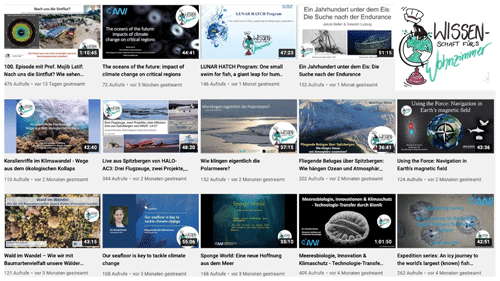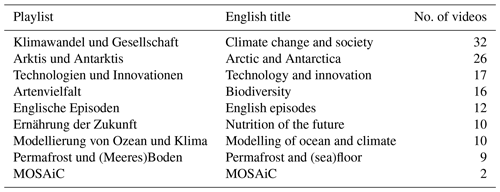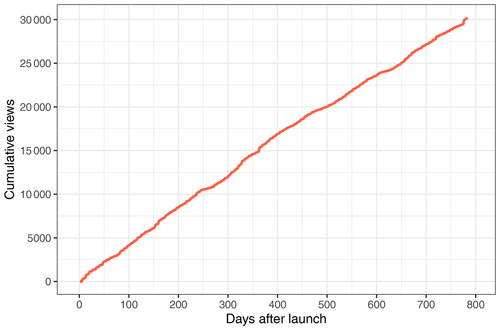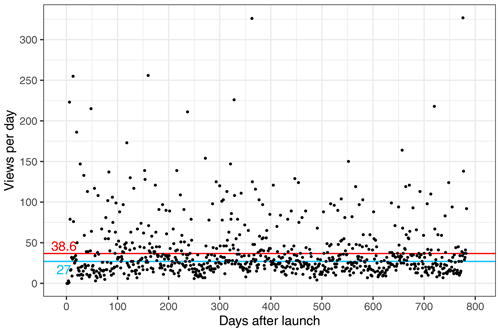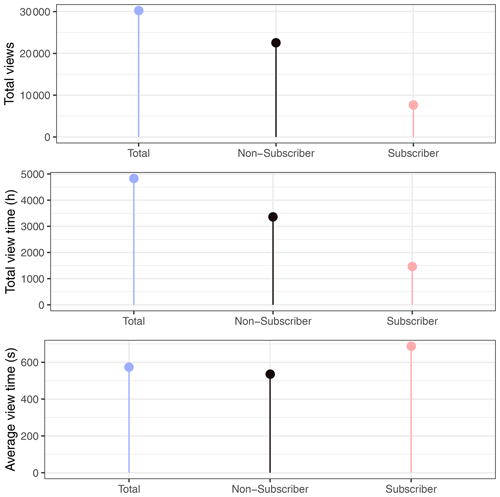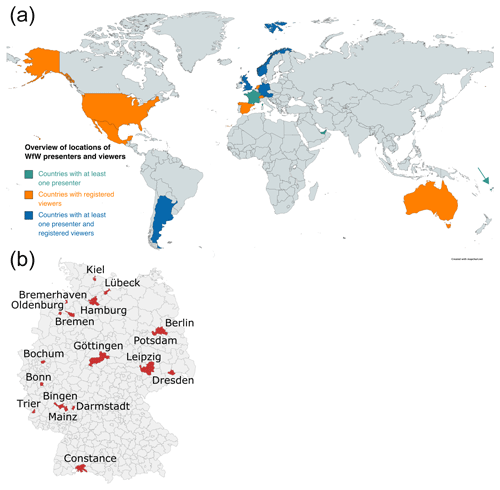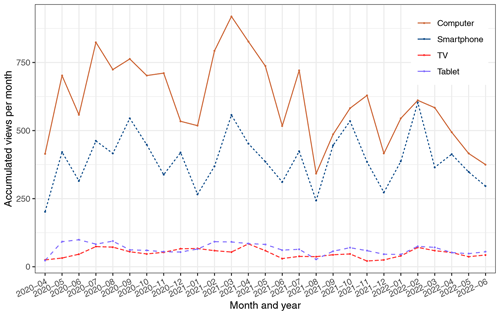“Wissenschaft fürs Wohnzimmer” – 2 years of weekly interactive, scientific livestreams on YouTube
Matthias Wietz
Stephan Juricke
Franziska Pausch
Corina Peter
Miriam Seifert
Jana C. Massing
Moritz Zeising
Rebecca A. McPherson
Melissa Käß
Björn Suckow
Science communication is becoming increasingly important to connect academia and society and to counteract misinformation. Online video platforms, such as YouTube, allow easily accessible communication of scientific knowledge to audiences made up of the general public. In April 2020, a diverse group of researchers from the Alfred Wegener Institute, Helmholtz Centre for Polar and Marine Research, launched the YouTube channel called “Wissenschaft fürs Wohnzimmer” (translated to “Living Room Science”) to stream scientific talks about climate change and biodiversity every Thursday evening, with the aim to reach a broad range of members of the public with a general interest in science and climate. Here we report on the numbers and diversity of content, viewers, and presenters from 2 years and 100 episodes of weekly livestreams. Presented topics encompass all areas of polar research, the scientific and societal aspects of climate change and biodiversity loss, and new technologies to deal with the changing world and climate of the future. We show that constant engagement by a group of co-hosts and presenters representing all topics, career stages, and genders enables the continuous growth of views and subscriptions, i.e. a measurable impact. After 783 d, the channel gained 30 251 views and 828 subscribers and hosted well-known scientists, while enabling especially early-career researchers to foster their outreach and media skills. We show that interactive and science-related videos, both live and on-demand, within a pleasant atmosphere, can be produced alongside the main research activity by scientists, while also maintaining high quality. We further discuss the challenges and possible improvements for the future. Our experiences will help other researchers conduct meaningful scientific outreach and push the boundaries of existing formats towards a better understanding of climate change and our planet.
- Article
(3783 KB) - Full-text XML
- BibTeX
- EndNote
Communicating science in times of human-made climate change, biodiversity loss, and the anticipated reaching of tipping points (Lenton et al., 2008; IPCC, 2013; Lenton et al., 2019; IPBES, 2019; IPCC, 2021; Vaidyanathan, 2021) has become important for researchers and society alike. Global science-driven movements such as Fridays for Future (Hagedorn et al., 2019) and Scientists for Future underline the interest in, and importance of, well-communicated scientific knowledge. The link between science denial and conspiracy theories, e.g. reflected in the denial of climate change and the misinformation during the COVID-19 pandemic (e.g. Lahrach and Furnham, 2017; Uscinski et al., 2017), emphasises the need to communicate scientific results in an approachable way. Scientific knowledge allows politicians, economists, and society to make appropriate decisions and draw conclusions based on fact, which is especially valuable during crises such as the COVID-19 pandemic and climate change (e.g. Bromme et al., 2022; Biermann et al., 2023). Commonly, the gap between science and society has been bridged by the media rather than academia, often resulting in inaccurate or sensationalised results that challenge the public's trust in the scientific community (e.g. Ladle et al., 2005; Jamieson et al., 2017; Krishna, 2021; Zerva et al., 2021; Fage-Butler et al., 2022). In addition to publishing in scholarly journals and presenting at conferences, scientists can reach an audience outside of academia and interact directly with the public. Blogs, homemade videos, and a variety of social media channels enable a change in the typical communication methods (Bickford et al., 2012; Bik and Goldstein, 2013; Huber et al., 2019; Pearce et al., 2019; Malik and Dhiman, 2022), which makes research more accessible to the public and thereby directly links science and society. Effective science communication allows people to make deliberate decisions by informing themselves about the risks and benefits of their actions (e.g. Intergovernmental Panel on Climate Change). Instead of following the mantra that “the public cannot understand science”, Fischhoff (2013) argues it should be “the public has little chance to learn science”. In his study, Fischhoff (2013) presents the following criteria to determine if communication is efficient: it has to (1) contain the needed information, (2) exist in places the audience can access, and (3) be offered in an understandable format. In return, scientists can gain the public's support by presenting the merits and trustworthiness of science (Fischhoff and Scheufele, 2013), if possible, in a dialogue form and encourage engagement from the public. Online science communication is a promising way to reach those goals, as it allows the posting of links to publications or fostering dialogue through comments and live discussions in forums or blogs, thus merging the physical world with online interaction (Bubela et al., 2009). However, the challenge remains to reach the public across age groups and education levels to generate an impact.
Producing science communication content for established media platforms, e.g. in the form of videos and podcasts, offers the possibility of reaching a broad audience. One of the most popular websites is YouTube, with over 1 billion monthly users (Similarweb, 2022). It offers a place to upload professional and homemade content covering sports, news, documentaries, music videos, tutorials, and more. The sheer volume of information available on the platform forces creators to attempt to understand how to capture the audience's (long-term) attention through markers of success, such as channel popularity, views, continuous growth in subscribers, comments, ratings, and number of shares (Burgess et al., 2009; Welbourne and Grant, 2016; Kohler and Dietrich, 2021; Yang et al., 2022; Chi and Park, 2022). Factors impacting success are, amongst others, the video length, continuity of content, reoccurring channel hosts, the pace of delivery, and whether the channel provides professional or user-generated content (Welbourne and Grant, 2016).
Scientific content on platforms such as YouTube still remains a niche, despite the platform's broad reach, and hence there is great potential to communicate science (Maynard, 2021). Unfortunately, YouTube is a site on which much misinformation about science is also distributed (Donzelli et al., 2018; Li et al., 2020; Hussein et al., 2020; Lemos et al., 2021; Li et al., 2022). Therefore, scientists could thus actively use the platform to directly counter misinformation. Furthermore, the constraints of the global COVID-19 pandemic forced scientists to rethink established approaches to reach the public, such as public presentations and group discussions. Thus, new challenges surfaced, such as (1) reaching an audience while most people were isolated at home, (2) developing concepts to attract people to attend online events, and (3) retaining this attention throughout months of pandemic-induced restrictions.
In summer 2019, scientists from the Alfred Wegener Institute, Helmholtz Centre for Polar and Marine Research (AWI), formed AWIs4Future, a regional group within Scientists4Future. In April 2020, a team of 11 early-career researchers (ECRs), active in AWIs4Future and from diverse disciplines, adapted the successful concept of the in-person event series called “Science goes Public” (https://www.sciencegoespublic.de, last access: 13 February 2023), in the German cities of Bremen and Bremerhaven to the internet, which enables scientists to casually talk about their research in pubs and bars twice a year. These free-of-charge events attracted a wide audience and were often fully booked. The pandemic forced “Science goes Public” (https://www.sciencegoespublic.de, last access: 13 February 2023) to cancel all events, necessitating the development of virtual alternatives to continue science communication while public life came to an almost standstill.
“Wissenschaft fürs Wohnzimmer” (WfW), translated to “Living Room Science”, aimed to bridge this gap by hosting moderated, weekly YouTube livestreams focusing primarily on climate- and environmental-science-related topics (Fig. 1). The main goals were to present current science topics of broad relevance in a widely understandable and entertaining way, enable easy access to the medium, remain free of charge for the audience, have a live and on-demand option, be interactive and offer a relaxed, inclusive atmosphere allowing the posting of questions to the experts, and showcase that scientists are not locked up in their ivory towers. In addition, the use of video conferences skyrocketed during the pandemic, thereby demonstrating the potential for further use in science communication. For instance, Zoom, an online meeting software offering a connection to YouTube, enables the hosting of live presentations and direct interaction with viewers worldwide via YouTube chat.
This article demonstrates the potential of establishing a low-cost, interactive, and accessible medium to communicate science to a broad audience. By sharing our experiences and best practices of the first 2 years of the WfW YouTube channel, we further aim to encourage other scientists to reach out to the public, thus contributing towards enhancing science communication between the public and the scientific community.
2.1 Streaming via YouTube
We launched the WfW channel on 18 April 2020, roughly 1 month after the first strict lockdown in Germany. The first livestream was broadcasted on the YouTube channel “TRR 181 Energy transfers in Atmosphere and Ocean” (https://www.youtube.com/channel/UCBqhp8gGCb1WNvNZZd_vBRQ, last access: 8 February 2023) and later re-uploaded to WfW (Fig. 1). We originally targeted the science-interested public in the north of Germany (owing to the location of AWI there). Hence, the majority of the talks are in German. Occasionally, WfW features presentations in English (12 in the analysed time frame). The presentations are generally between 20–45 min long, followed by 15 min of questions, aiming at a total streaming time of 45–60 min. There are no requirements to watch the videos, and only a free YouTube account is necessary to participate in the live chat with the online audience, where questions are encouraged. To enable additional interaction, the audience is encouraged to add comments or questions afterwards and contact WfW via the AWIs4Future accounts on Instagram and Twitter (now renamed X).
2.2 Live discussion via Zoom
A Zoom One Pro account is used for a video call between three WfW hosts and one or two presenters. We use Zoom One Pro because of unlimited meeting time, direct streaming to YouTube, control over key settings (e.g. privacy), and communication among the host team via the chat function. The account is financed via prize money from the AWI Award for Science Communication dedicated to AWIs4Future in 2020. However, discussions about using a non-commercial, open-source, and free broadcast alternative, such as Open Broadcaster Software (OBS), are ongoing. The host team is usually gender-balanced, consisting of scientists from different research disciplines and different career stages, ranging from new doctoral researchers to established postdocs and senior scientists, who are mainly from AWI. The team meets 20–30 min prior to the livestream to perform a technical check and to discuss relevant details, such as the introduction, order of events, and the way to announce the next week's presenter. Around 30 s before the beginning of the livestream, all conversations are ended and microphones are muted. The stream is started, appearing with a 30 s delay to the live viewers. After playing the WfW jingle (https://soundcloud.com/livingroom7a/wfw, last access: 18 June 2023), recorded by a WfW team member and band, one co-host welcomes the audience, then introduces themselves and the presenter. The other two co-hosts present themselves, and the presenter takes over.
During the presentation, the presenter leads the audience through their slides and is the only one speaking. Questions are normally answered after the presentation, based on the YouTube live chat monitored and moderated by one co-host. Occasionally, one of the co-hosts asks questions from the YouTube chat during the presentation, which can create a more lively and communicative atmosphere instead of a more typical “lecture” format. Depending on the audience, the discussion can include up to a dozen questions ranging from basic to very specific. Spam and abusive comments occur rarely. In those cases, these comments are deleted and respective users blocked directly afterwards. The discussion usually ends after a maximum of 20 min, and the WfW jingle concludes the livestream and the recording. In a debriefing, the presenter is informed about the statistics, such as the number of live viewers and activity in the chat. A pleasant and often more in-depth discussion usually continues between the co-hosts and the presenter before the Zoom meeting is concluded.
2.3 Post-processing and on-demand content
The recorded stream is automatically uploaded to YouTube. A few videos were edited slightly after the livestream, e.g. to cut out corrupted parts due to failed internet connection. The comment section below the videos remains open and is regularly monitored by the WfW team. Submitted questions are answered or, if necessary, forwarded to the presenter. Talks are sorted by content and placed in at least one of nine different playlists (Table 1) for quick browsing.
The WfW channel (https://www.youtube.com/c/ WissenschaftfürsWohnzimmer, last access: 7 August 2023) was created on 18 April 202,0 and the first video was uploaded on 19 April 2020. As of 9 June 2022, WfW has hosted 100 scientific livestreams, whose statistics are presented in this study. Streams took place every Thursday, except over Christmas and Easter holidays and during a 1-month summer break in 2021.
3.1 Views
3.1.1 Overview
The analysed time frame contains about 2 years (18 April 2020–9 June 2022) and reveals that the WfW channel gathered an accumulated number of 30 251 views (Fig. 2). Based on available YouTube information, one legitimate view is defined as intentionally clicking a video and watching a minimum of 30 s. There was a total of 10 645 views in 2020, 13 512 views in 2021, and 6094 views until 9 June 2022, with a steady increase in cumulative views over the 783 d analysed (Fig. 2).
Daily views of the channel are up to 327 (Fig. 3). The lowest numbers were recorded on the Christmas, New Year, and summer breaks of 2020 and 2021. The highest numbers (326 and 327) were reached on the 50th and 100th episodes of WfW, featuring the publicly known scientists Gregor Hagedorn (founder of Scientists for Future) and Mojib Latif (GEOMAR Helmholtz Centre for Ocean Research Kiel and Kiel University), respectively. The average and median number of views per day are 38.6 and 27, respectively (Fig. 3). Views are generally highest on Thursdays when new content is streamed live.
3.1.2 Single video views and viewing time
The three most viewed videos on the channel (streamed in summer or autumn of 2020) have 868, 841, and 824 views, respectively. The least streamed video (68 times) was streamed on 19 May 2022. The first video, which is posted on two channels, has a total of 1088 views (435 on WfW and 653 on the TRR 181 channel). However, views increase with time and are thus difficult to compare.
Videos on the WfW channel were watched for a total of 4829.9 h. The cumulative viewing time per video ranges from 10.1 to 146.2 h, with an average play time of 5:07 min to 20:04 min.
3.2 Subscriptions
WfW has 828 subscribers as of 9 June 2022 (Fig. 4b), corresponding to 0.9 subscriptions per day, 7.4 subscriptions per week, and 32.2 subscriptions per month. Subscriptions per day range from −3 to 26 (Fig. 4a). The strong increase in subscriptions (Fig. 4) coincides with presentations by the publicly known scientists like Mojib Latif, Peter Lemke, and Gregor Hagedorn. Consequently, WfW also gained the most new subscribers in connection with the presentations of Gregor Hagedorn and Mojib Latif, with 19 and 18 new subscriptions per video, respectively. Times of stagnation coincide with periods of channel inactivity, such as the summer breaks, Christmas, and New Year in 2020 and 2021.
In total, 74.6 % of all views come from users without a subscription to WfW (22 573) and 25.4 % are from WfW subscribers (7678). Similarly, the total viewing time of non-subscribers is 3364 h, whereas subscribers watched for a total time of 1466 h (Fig. 5). Subscribers watch on average longer (around 11.5 min) than non-subscribers (around 9 min; Fig. 5).
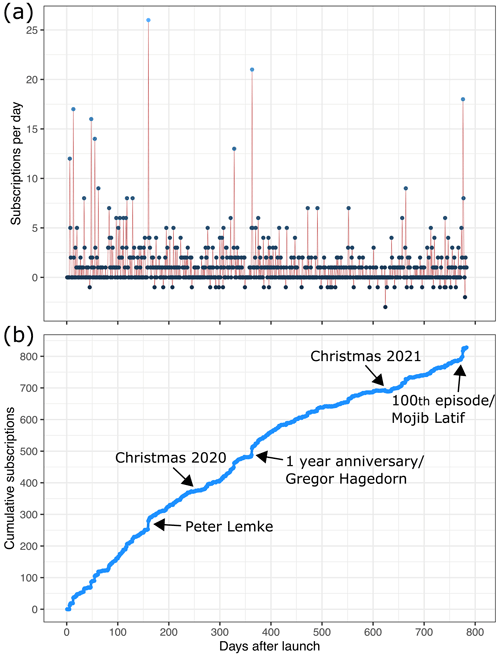
Figure 4 (a) Subscriptions gained or lost per day. (b) Cumulative number of subscriptions. High- and low-impact events are marked.
3.3 Data on viewers
Specific viewer data (e.g. location, age, and gender) are only available for viewers with a YouTube account. Confirming the viewer data would require a dedicated survey, which is beyond our capacity. We thus only evaluate data not declared by the viewer but recorded by YouTube, such as the country and medium of access. WfW episodes were accessed from 11 different countries within Europe, North America, South America, and Oceania (Fig. 6). The majority of views were from Germany (70.2 %), followed by minimal contributions from Argentina (0.2 %), Switzerland (0.2 %), and Spain (0.1 %). Less than 0.1 % of viewers originated from Austria, Mexico, Norway, Australia, the United Kingdom, the Netherlands, and the United States of America. The country of access was not identifiable for the remaining cases.
The computer is the main medium of accessing WfW, with a total of 16 445 views (54.4 %), followed by 10 628 views (35.1 %) on smartphones, 1767 views (5.8 %) on tablets, and 1337 views (4.4 %) on TVs. The devices used for the missing 74 views could not be determined. The viewing trend over time is similar for all devices (Fig. 7). Access numbers from the computer and the smartphone rise and fall in similar months. Tablet and TV access is generally much lower but also more constant. Interestingly, average viewing times differ strongly between the different devices. The longest average viewing time is reached by users with TVs (around 17 min), followed by tablets (around 13 min), computers (10.5 min), and smartphones (6.5 min).
3.4 Topics and presenters
We hosted presentations from different disciplines, with natural sciences as the central topic, ranging from biology and glaciology to climate modelling. Other fields included social sciences, psychology, politics, city and landscape planning, aquaculture, and technology development. For example, WfW featured the role of ocean currents, the ecological importance and modelling of plankton, the characterisation of ecosystems from the deep sea to the tropics, and the drilling of ice cores in Greenland. Several talks were highly interdisciplinary and connected different research fields. These talks were grouped in more than one topic. The main topics were biology and biodiversity, technology and innovation, the polar regions, and climate change impacts, with 25, 22, 20, and 12 talks, respectively. The 100 WfW episodes were presented by 91 speakers, while nine scientists presented multiple times. Presenters were mainly senior researchers (46), i.e. >7 years postdoctoral, ECRs (39), and non-academics (15). They represent 38 different affiliations from 26 locations, mainly from Europe (23) and especially Germany (17; Fig. 6), plus presenters from Argentina, Fiji, and the United Arab Emirates. A total of 12 presentations were held in English (Table 1).
In the first month, presentations were done by the WfW team to kick-start the format; consequentially, the focus was on AWI-related research. Over time, covered topics spanned biology, oceanography, glaciology, climate modelling, permafrost, sea ice physics, geology, and chemistry. In addition, two contributions were related to the Multidisciplinary drifting Observatory for the Study of Arctic Climate (MOSAiC) expedition and presented photos, videos, and first results of the research (e.g. Nicolaus et al., 2022; Rabe et al., 2022).
We created playlists to group streams by topic. However, the number of videos per playlist varies, and videos can belong to different playlists; making statistics difficult to compare. The playlist with the highest number of videos are Klimawandel und Gesellschaft (Climate change and society; n=32) and Arktis und Antarktis (Arctic and Antarctic; n=26; Table 1).
After 2 years of livestreaming, WfW has been established as an easily accessible and regular source of up-to-date scientific content. The channel's success is mirrored by the positive trend of subscribers and the continuous rise in total views (Figs. 2 and 4). Being a non-commercial channel only maintained by volunteers from AWI, WfW does not aim to reach the level of professional German-speaking channels, such as maiLab (https://www.youtube.com/c/mailab, last access: 2 March 2023) or Quarks (https://www.youtube.com/c/Quarks, last access: 2 March 2023). However, the approach of delivering content regularly has resulted in continuous, long-term growth (Figs. 2 and 4).
WfW has been able to address current topics, such as the federal election in Germany in September 2021 (streamed on 29 July 2021), the finding of an extensive colony of fish nests in Antarctica (streamed on 3 February 2022; Purser et al., 2022), and the rediscovery of the ship wreck of the polar explorer Endurance (streamed on 5 May 2022).
4.1 Direct science communication
WfW enables a direct method of science communication. The scientific work is not rewritten by journalists or quoted but directly and personally presented by researchers. Such direct contact between the public and science is usually limited in popular media and, if occurring, typically only lasts a couple of minutes. Usually, researchers only have a limited capacity for science communication apart from their everyday tasks, as it is seldom included in the labour contract; hence, media platforms often inform the public about science topics without directly consulting a researcher from that specific field.
Especially in media, but also in research, some topics attract a great deal of public attention, such as the possible crossing of a tipping point of the Greenland Ice Sheet (e.g. King et al., 2020) or the finding of a vast fish breeding colony in Antarctica (Purser et al., 2022). While WfW also presents such science themes, we similarly broadcast research from niche topics. At WfW, among many more, the following topics were discussed: deformation in ice, blue carbon, seafloor organisms, country–city migration in India, the imperial way of living, and modelling of phytoplankton community changes and species distribution. Most topics are related to climate change and/or biodiversity loss but are barely discussed in the public media. Providing a platform to present state-of-the-art research on such topics for the experts from these fields is thus a win–win situation for the audience and the presenter.
4.2 Range of topics and presenters
One of the major perks of WfW is the broad range of themes and research methods presented and the possibility of getting to know the people behind the science by also asking personal questions, hence making researchers more reachable. The topics are rooted within the overall theme of the changing Earth system and habitats connected to climate change and biodiversity crisis, thus allowing the audience to learn about a new field of research each week. Furthermore, it represents many facets of climate-related research and the need for interdisciplinary collaborations with the public. These different research fields rely on various methods ranging from laboratory work to modelling, fieldwork, and observational data. WfW communicates different scientific disciplines and highlights the importance of interdisciplinary research by incorporating both observational and computed data from diverse fields.
4.3 Impact
A crucial goal for science communication is to maximise reach while delivering accurate, easily understandable, and non-populist content. However, what constitutes a significant impact on public audiences? Realistic goals are necessary to set the right conditions so that the expectations of the audience and the host are met.
A medium such as WfW cannot, and does not attempt, to compete with professional products or federally funded platforms. The strengths of WfW are its wide variety of topics, interactivity, easy access, and a minimum number of obstacles related to access and participation. It is furthermore a bottom-up approach driven by self-motivation. The steady increase in subscriptions and total views demonstrates a successful strategy. Reaching hundreds of people with such a range of diverse topics on a weekly basis for over 2 years is a rewarding endeavour for our group of volunteers, all of whom work full-time in academia.
The weekly output, fixed at a specific time and date, is one of the main reasons for the success of WfW. Welbourne and Grant (2016) show that videos with consistent science communicators are more popular than videos without a regular communicator. The hosting of WfW by a small group of scientists, who alternate this role each week to avoid monotony, creates regularity and a sense of familiarity. Specifically, WfW aims to include a diversity of scientists from different disciplines and career stages.
The feedback from the audience and the presenters is generally very positive, resulting in several regular viewers and recurring presenters. Feedback is typically posted directly in the YouTube chat and is openly accessible beneath each video. Speakers often suggest or enlist new presenters, which helps to establish a broad network of potential guests and varying fields of expertise. The main points of positive feedback that are repeatedly mentioned are (1) the welcoming atmosphere of both hosts and viewers and the smooth procedure, (2) the direct communication with the viewers, and (3) the wide range of topics addressed.
An active social media presence is also one of the most critical points for WfW. X (formerly Twitter), Instagram, Facebook, and the local media are valuable tools for advertising each episode and the channel. In addition, hosting publicly known researchers showed a positive effect, which resulted in more-than-average live views. Such high-impact events can thus help to gain live views and new subscribers to the channel.
4.4 Challenges
We identified the following major challenges in establishing and maintaining a successful online outreach medium: (1) keeping a steady and high output, (2) generating new views and subscriptions, (3) balancing seasonal and weather-related ups and downs in views, and (4) organising three live hosts and a presenter each Thursday evening, especially in the face of unforeseen cancellations. Minor challenges are the recruiting of new presenters, the funding of the Zoom account, and the development of a concept to deliver shorter videos.
We have been contacted by companies that aimed to present their products or approaches to solving specific issues. These requests are moral dilemmas because they are somewhere between research and business. Such proposals are evaluated thoroughly to avoid being hijacked as a marketing platform. So far, no purely commercial product has been presented. WfW refuses to advertise for companies that focus on sustainability topics. However, some presenters have shared information about their work in new start-ups as part of their research.
From the viewpoint of research institutes, efforts in science communication are little recognised, with the publishing of peer-reviewed papers remaining the benchmark. Valuing the effort and reach of science communication would foster projects like WfW and attract more scientists by guaranteeing a certain professional benefit.
4.5 Fostering public and transdisciplinary science communication and collaborations
In addition to bringing science to the living room at any time and date, WfW also has the intention to provide a training platform for researchers. Most presenters are exposed to a form of public science communication many have not yet experienced. They thus practice their presentation skills while expanding their own network and communication range; in particular, ECRs can sharpen their skills in a moderated and safe environment while choosing the topic and manner of presenting themselves. The AWI graduate school POLMAR has incorporated WfW in its catalogue, thus allowing doctoral researchers to gain credit points for successful presentations at WfW. Training is needed to improve the ability to become a good science communicator. A platform such as WfW is an easily accessible starting point for refining science communication skills.
In such a large institute as AWI, with over 1200 employees, WfW has also fostered interdisciplinary communication and discussions. Thus, the project led to novel intra-organisational cooperation that did not exist before. Engaged scientists got to know each other and their respective research areas better, thereby creating both outreach and in-reach. Furthermore, hosts benefit from establishing new collaborations and scientific exchanges outside of AWI. WfW has already resulted in one scientific collaboration on the chemical and microbiological coupling between ocean and atmosphere in the Arctic. This project between AWI and the Leibniz Institute for Tropospheric Research (TROPOS) was initiated between the presenter and one of the WfW hosts following episode 51 (https://youtu.be/Nb38ZyR4CrA, last access: 8 August 2023) and resulted in joint sampling campaigns on Svalbard that were subsequently presented in episode 91 (https://youtu.be/DcHpKeDldqw, last access: 8 August 2023).
4.6 Lessons learnt and ideas for the future
The success of WfW shows a broad public interest in a platform offering a variety of scientific topics. However, expanding and improving the channel while keeping it relevant and practically feasible is a significant challenge, and two approaches are discussed here.
To reduce the regular workload and appeal to the public's short-term attention span of only a few minutes, especially for smartphone users (Fig. 7), we will try new formats in the channel. One idea is briefly introducing a researcher and their topic via social media. Interested followers can then ask direct questions to the researcher in an interview, and an edited short version of this interview will be uploaded. This approach allows the content and creators to remain on an equal footing with the audience, while still producing videos that are much shorter than the usual presentations and discussions that are streamed (5 vs. 45 min). Our data show that the average viewer only watches part of the video (Fig. 5). This is likely due to the varying interest of the audience, the high competition of other videos (that are just a click away), and the general shortening of people's attention span (Carstens et al., 2018; Firth et al., 2020). The average viewing time depends on the device used for access (Fig. 7), confirming the general theory that shorter content has great potential. Therefore, the content will be shorter but more focused on specific sections. Theoretically, this approach is more interactive, since the followers' engagement on platforms like Twitter and Instagram is higher and quicker. Finally, this approach could attract a wider audience, while requiring less time and involvement of the WfW team because the content can be created independently and in advance. However, a challenge here is to compete with the highly professional content already available. The focus would not be on the quality of the graphics and design of the videos but on the authenticity of the presenting scientist and their work. Furthermore, it allows viewers to engage with the presenters through live chat questions or the comment function.
Self-directed videos of typical lab sessions, measurement procedures, or expeditions are another promising approach. Creators will record videos using a smartphone and are thus free to choose the focus of their video. The maximum duration is a couple of minutes, which would especially cater for users using smartphones or tablets. As more than one-third of the total views originate from smartphones (Fig. 7), content adapted to this medium has considerable potential. The WfW team will edit the videos by adding subtitles, links, and background music to enhance the overall attractiveness, with subtitles mainly targeting smartphone users again.
These approaches might offer a broader, more diverse content catalogue to complement the current presentation and discussion format. However, to maintain the WfW main objective, regular livestreams are still envisioned every second week, while question-oriented and self-directed videos take turns in the open slots.
“Wissenschaft fürs Wohnzimmer” (WfW) is an interactive YouTube channel offering weekly livestreams on climate (change), the polar regions, biodiversity, and other related topics. The principal aim was establishing an easily accessible, interactive platform for attractive science communication during the first COVID-19 lockdown in early 2020. However, the channel continues to run successfully and has established itself as a platform producing regular, quality output and allowing for community interaction. Subscriptions and views have been rising continuously since the start of the channel; times of inactivity (e.g. Christmas and summer breaks) are the only times of stagnation. Constant numbers of live viewers highlight our success, and we recorded up to several hundreds of clicks after only a few weeks. Moreover, TV users watch, on average, twice as long as computer and smartphone or tablet users, thus displaying a broad audience. We identify major lessons learnt from 2 years of WfW and discuss ways to improve further the quality, accessibility, and impact of WfW. Insights into our experiences will be helpful for similar activities by other researchers and allow easier access for novel channels or people new to science communication.
Data are available at Zenodo (https://doi.org/10.5281/zenodo.8223888, Stoll et al., 2023).
All episodes of WfW are publicly available on the Wissenschaft fürs Wohnzimmer YouTube channel at https://www.youtube.com/c/WissenschaftfürsWohnzimmer (Wissenschaft fürs Wohnzimmer, 2023).
NS, MW, SJ, FP, CP, JCM, MS, MZ, MK, RAM, and BS are the core team behind WfW, who designed the study and collected the data. NS, MW, SJ, FP, and MS wrote the paper, with contributions from all co-authors.
The contact author has declared that none of the authors has any competing interests.
Publisher's note: Copernicus Publications remains neutral with regard to jurisdictional claims in published maps and institutional affiliations.
We thank all WfW supporters, AWIs4Future, and all guests presenting their research.
This paper was edited by Rainer Lehmann and reviewed by Inga Beck and one anonymous referee.
Bickford, D., Posa, M. R. C., Qie, L., Campos-Arceiz, A., and Kudavidanage, E. P.: Science communication for biodiversity conservation, Biol. Conserv., 151, 74–76, https://doi.org/10.1016/j.biocon.2011.12.016, 2012. a
Biermann, K., Peters, N., and Taddicken, M.: “You Can Do Better Than That!”: Tweeting Scientists Addressing Politics on Climate Change and Covid-19, Media and Communication, 11, 1, https://doi.org/10.17645/mac.v11i1.5961, 2023. a
Bik, H. M. and Goldstein, M. C.: An Introduction to Social Media for Scientists, PLOS Biol., 11, e1001535, https://doi.org/10.1371/journal.pbio.1001535, 2013. a
Bromme, R., Mede, N. G., Thomm, E., Kremer, B., and Ziegler, R.: An anchor in troubled times: Trust in science before and within the COVID-19 pandemic, PLOS ONE, 17, e0262823, https://doi.org/10.1371/journal.pone.0262823, 2022. a
Bubela, T., Nisbet, M. C., Borchelt, R., Brunger, F., Critchley, C., Einsiedel, E., Geller, G., Gupta, A., Hampel, J., Hyde-Lay, R., Jandciu, E. W., Jones, S. A., Kolopack, P., Lane, S., Lougheed, T., Nerlich, B., Ogbogu, U., O'Riordan, K., Ouellette, C., Spear, M., Strauss, S., Thavaratnam, T., Willemse, L., and Caulfield, T.: Science communication reconsidered, Nat. Biotechnol., 27, 514–518, https://doi.org/10.1038/nbt0609-514, 2009. a
Burgess, J., Green, J., Jenkins, H., and Hartley, J.: YouTube: Online Video and Participatory Culture (DMS – Digital Media and Society), Polity Press, Cambridge, ISBN 978-0-7456-4478-3, 2009. a
Carstens, D. S., Doss, S. K., and Kies, S. C.: Social Media Impact on Attention Span, J. Manage. Eng. Int., 11, 20–27, 2018. a
Chi, Y. and Park, E.: Counterattacking long videos: exploring the characteristics of popular instant videos and roles of producers and viewers, Library Hi Tech, 41, 694–710, https://doi.org/10.1108/LHT-05-2022-0230, 2022. a
Donzelli, G., Palomba, G., Federigi, I., Aquino, F., Cioni, L., Verani, M., Carducci, A., and Lopalco, P.: Misinformation on vaccination: A quantitative analysis of YouTube videos, Hum. Vacc. Immunother., 14, 1654–1659, https://doi.org/10.1080/21645515.2018.1454572, 2018. a
Fage-Butler, A., Ledderer, L., and Nielsen, K. H.: Public trust and mistrust of climate science: A meta-narrative review, Public Underst. Sci., 31, 832–846, https://doi.org/10.1177/09636625221110028, 2022. a
Firth, J. A., Torous, J., and Firth, J.: Exploring the Impact of Internet Use on Memory and Attention Processes, Int. J. Environ. Res. Pub. He., 17, 9481, https://doi.org/10.3390/ijerph17249481, 2020. a
Fischhoff, B.: The sciences of science communication, P. Natl. Acad. Sci. USA, 110, 14033–14039, https://doi.org/10.1073/pnas.1213273110, 2013. a, b
Fischhoff, B. and Scheufele, D. A.: The science of science communication, P. Natl. Acad. Sci. USA, 110, 14031–14032, https://doi.org/10.1073/pnas.1312080110, 2013. a
Hagedorn, G., Loew, T., Seneviratne, S. I., Lucht, W., Beck, M.-L., Hesse, J., Knutti, R., Quaschning, V., Schleimer, J.-H., Mattauch, L., Breyer, C., Hübener, H., Kirchengast, G., Chodura, A., Clausen, J., Creutzig, F., Darbi, M., Daub, C.-H., Ekardt, F., Göpel, M., Judith N., H., Hertin, J., Hickler, T., Köhncke, A., Köster, S., Krohmer, J., Kromp-Kolb, H., Leinfelder, R., Mederake, L., Neuhaus, M., Rahmstorf, S., Schmidt, C., Schneider, C., Schneider, G., Seppelt, R., Spindler, U., Springmann, M., Staab, K., Stocker, T. F., Steininger, K., Hirschhausen, E. V., Winter, S., Wittau, M., and Zens, J.: The concerns of the young protesters are justified: A statement by Scientists for Future concerning the protests for more climate protection, GAIA, 28, 79–87, https://doi.org/10.14512/gaia.28.2.3, 2019. a
Huber, B., Barnidge, M., Gil de Zuniga, H., and Liu, J.: Fostering public trust in science: The role of social media, Public Underst. Sci., 28, 759–777, 2019. a
Hussein, E., Juneja, P., and Mitra, T.: Measuring Misinformation in Video Search Platforms: An Audit Study on YouTube, Proceedings of the ACM on Human-Computer Interaction, 4, 1–27, https://doi.org/10.1145/3392854, 2020. a
IPBES: Summary for policymakers of the global assessment report on biodiversity and ecosystem services of the Intergovernmental Science-Policy Platform on Biodiversity and Ecosystem Services., Tech. rep., IPBES secretariat, Bonn, Germany, Zenodo, https://doi.org/10.5281/zenodo.3553579, 2019. a
IPCC: IPCC 13 Observations: Cryosphere, Climate Change 2013: The Physical Science Basis, Contribution of Working Group I to the Fifth Assessment Report of the Intergovernmental Panel on Climate Change, 317–382, https://doi.org/10.1017/CBO9781107415324.012, 2013. a
IPCC: Climate Change 2021: The Physical Science Basis, Contribution of Working Group I to the Sixth Assessment Report of the Intergovernmental Panel on Climate Change, Tech. rep., Intergovernmental Panel on Climate Change, Cambridge, United Kingdom and New York, NY, USA, https://doi.org/10.1017/9781009157896, 2021. a
Jamieson, K. H., Kahan, D. M., and Scheufele, D.: The Oxford Handbook of the Science of Science Communication, Oxford University Press, ISBN 9780190497620, 2017. a
King, M. D., Howat, I. M., Candela, S. G., Noh, M. J., Jeong, S., Noël, B. P. Y., van den Broeke, M. R., Wouters, B., and Negrete, A.: Dynamic ice loss from the Greenland Ice Sheet driven by sustained glacier retreat, Commun. Earth Environ., 1, 1–7, https://doi.org/10.1038/s43247-020-0001-2, 2020. a
Kohler, S. and Dietrich, T. C.: Potentials and Limitations of Educational Videos on YouTube for Science Communication, Front. Commun., 6, https://doi.org/10.3389/fcomm.2021.581302, 2021. a
Krishna, A.: Understanding the differences between climate change deniers and believers' knowledge, media use, and trust in related information sources, Public Relat. Rev., 47, 101986, https://doi.org/10.1016/j.pubrev.2020.101986, 2021. a
Ladle, R. J., Jepson, P., and Whittaker, R. J.: Scientists and the media: the struggle for legitimacy in climate change and conservation science, Interdiscipl. Sci. Rev., 30, 231–240, https://doi.org/10.1179/030801805X42036, 2005. a
Lahrach, Y. and Furnham, A.: Are modern health worries associated with medical conspiracy theories?, J. Psychosom. Res., 99, 89–94, https://doi.org/10.1016/j.jpsychores.2017.06.004, 2017. a
Lemos, A. L. M., Bitencourt, E. C., and dos Santos, J. G. B.: Fake news as fake politics: the digital materialities of YouTube misinformation videos about Brazilian oil spill catastrophe, Media Cult. Soc., 43, 886–905, https://doi.org/10.1177/0163443720977301, 2021. a
Lenton, T. M., Held, H., Kriegler, E., Hall, J. W., Lucht, W., Rahmstorf, S., and Schellnhuber, H. J.: Tipping elements in the Earth's climate system, P. Natl. Acad. Sci. USA, 105, 1786–1793, https://doi.org/10.1073/pnas.0705414105, 2008. a
Lenton, T. M., Rockström, J., Gaffney, O., Rahmstorf, S., Richardson, K., Steffen, W., and Schellnhuber, H. J.: Climate tipping points – too risky to bet against, Nature, 575, 592–595, https://doi.org/10.1038/d41586-019-03595-0, 2019. a
Li, H. O.-Y., Bailey, A., Huynh, D., and Chan, J.: YouTube as a source of information on COVID-19: a pandemic of misinformation?, BMJ Global Health, 5, e002604, https://doi.org/10.1136/bmjgh-2020-002604, 2020. a
Li, H. O.-Y., Pastukhova, E., Brandts-Longtin, O., and Tan, M. G.: YouTube as a source of misinformation on COVID-19 vaccination: a systematic analysis, BMJ Global Health, 7, e008334, https://doi.org/10.1136/bmjgh-2021-008334, 2022. a
Malik, P. S. and Dhiman, B.: Science Communication in India: Current Trends and Future Vision, Journal of Digital Media Management, 4, 1–4, https://doi.org/10.47363/JMM/2022(4)144, 2022. a
Maynard, A. D.: How to Succeed as an Academic on YouTube, Front. Commun., 5, 1–9, https://doi.org/10.3389/fcomm.2020.572181, 2021. a
Nicolaus, M., Perovich, D. K., Spreen, G., Granskog, M. A., von Albedyll, L., Angelopoulos, M., Anhaus, P., Arndt, S., Jakob Belter, H., Bessonov, V., Birnbaum, G., Brauchle, J., Calmer, R., Cardellach, E., Cheng, B., Clemens-Sewall, D., Dadic, R., Damm, E., de Boer, G., Demir, O., Dethloff, K., Divine, D. V., Fong, A. A., Fons, S., Frey, M. M., Fuchs, N., Gabarró, C., Gerland, S., Goessling, H. F., Gradinger, R., Haapala, J., Haas, C., Hamilton, J., Hannula, H. R., Hendricks, S., Herber, A., Heuzé, C., Hoppmann, M., Høyland, K. V., Huntemann, M., Hutchings, J. K., Hwang, B., Itkin, P., Jacobi, H. W., Jaggi, M., Jutila, A., Kaleschke, L., Katlein, C., Kolabutin, N., Krampe, D., Kristensen, S. S., Krumpen, T., Kurtz, N., Lampert, A., Lange, B. A., Lei, R., Light, B., Linhardt, F., Liston, G. E., Loose, B., Macfarlane, A. R., Mahmud, M., Matero, I. O., Maus, S., Morgenstern, A., Naderpour, R., Nandan, V., Niubom, A., Oggier, M., Oppelt, N., Pätzold, F., Perron, C., Petrovsky, T., Pirazzini, R., Polashenski, C., Rabe, B., Raphael, I. A., Regnery, J., Rex, M., Ricker, R., Riemann-Campe, K., Rinke, A., Rohde, J., Salganik, E., Scharien, R. K., Schiller, M., Schneebeli, M., Semmling, M., Shimanchuk, E., Shupe, M. D., Smith, M. M., Smolyanitsky, V., Sokolov, V., Stanton, T., Stroeve, J., Thielke, L., Timofeeva, A., Tonboe, R. T., Tavri, A., Tsamados, M., Wagner, D. N., Watkins, D., Webster, M., and Wendisch, M.: Overview of the MOSAiC expedition: Snow and sea ice, Elementa, 10, 1, https://doi.org/10.1525/elementa.2021.000046, 2022. a
Pearce, W., Niederer, S., Özkula, S. M., and Sánchez Querubín, N.: The social media life of climate change: Platforms, publics, and future imaginaries, WIREs Clim. Change, 10, e569, https://doi.org/10.1002/wcc.569, 2019. a
Purser, A., Hehemann, L., Boehringer, L., Tippenhauer, S., Wege, M., Bornemann, H., Pineda-Metz, S. E., Flintrop, C. M., Koch, F., Hellmer, H. H., Burkhardt-Holm, P., Janout, M., Werner, E., Glemser, B., Balaguer, J., Rogge, A., Holtappels, M., and Wenzhoefer, F.: A vast icefish breeding colony discovered in the Antarctic, Curr. Biol., 32, 842–850, https://doi.org/10.1016/j.cub.2021.12.022, 2022. a, b
Rabe, B., Heuzé, C., Regnery, J., Aksenov, Y., Allerholt, J., Athanase, M., Bai, Y., Basque, C., Bauch, D., Baumann, T. M., Chen, D., Cole, S. T., Craw, L., Davies, A., Damm, E., Dethloff, K., Divine, D. V., Doglioni, F., Ebert, F., Fang, Y.-C., Fer, I., Fong, A. A., Gradinger, R., Granskog, M. A., Graupner, R., Haas, C., He, H., He, Y., Hoppmann, M., Janout, M., Kadko, D., Kanzow, T., Karam, S., Kawaguchi, Y., Koenig, Z., Kong, B., Krishfield, R. A., Krumpen, T., Kuhlmey, D., Kuznetsov, I., Lan, M., Laukert, G., Lei, R., Li, T., Torres-Valdés, S., Lin, L., Lin, L., Liu, H., Liu, N., Loose, B., Ma, X., McKay, R., Mallet, M., Mallett, R. D. C., Maslowski, W., Mertens, C., Mohrholz, V., Muilwijk, M., Nicolaus, M., O’Brien, J. K., Perovich, D., Ren, J., Rex, M., Ribeiro, N., Rinke, A., Schaffer, J., Schuffenhauer, I., Schulz, K., Shupe, M. D., Shaw, W., Sokolov, V., Sommerfeld, A., Spreen, G., Stanton, T., Stephens, M., Su, J., Sukhikh, N., Sundfjord, A., Thomisch, K., Tippenhauer, S., Toole, J. M., Vredenborg, M., Walter, M., Wang, H., Wang, L., Wang, Y., Wendisch, M., Zhao, J., Zhou, M., and Zhu, J.: Overview of the MOSAiC expedition: Physical oceanography, Elementa, 10, 1–31, https://doi.org/10.1525/elementa.2021.00062, 2022. a
Similarweb: Top Website-Ranking, https://www.similarweb.com/de/top-websites/ (last access: 20 June 2022), 2022. a
Stoll, N., Wietz, M., Juricke, S., Pausch, F., Peter, C., Seifert, M., Massing, J. C., Zeising, M., McPherson, R. A., Käß, M., and Suckow, B.: Data for publication “Wissenschaft fürs Wohnzimmer” – 2 years of weekly interactive, scientific livestreams on YouTube in Journal Polarforschung, Zenodo [data set], https://doi.org/10.5281/zenodo.8223888, 2023. a
Uscinski, J. E., Douglas, K., and Lewandowsky, S.: Climate Change Conspiracy Theories, in: Oxford Research Encyclopedia of Climate Science, Oxford University Press, https://doi.org/10.1093/acrefore/9780190228620.013.328, 2017. a
Vaidyanathan, G.: The world’s species are playing musical chairs: how will it end?, Nature, 596, 22–25, https://doi.org/10.1038/d41586-021-02088-3, 2021. a
Welbourne, D. J. and Grant, W. J.: Science communication on YouTube: Factors that affect channel and video popularity, Public Underst. Sci., 25, 706–718, https://doi.org/10.1177/0963662515572068, 2016. a, b, c
Wissenschaft fürs Wohnzimmer: Wissenschaft fürs Wohnzimmer, YouTube [video], https://www.youtube.com/@WissenschaftfursWohnzimmer, last access: 9 August 2023. a
Yang, S., Brossard, D., Scheufele, D. A., and Xenos, M. A.: The science of YouTube: What factors influence user engagement with online science videos?, PLOS ONE, 17, e0267697, https://doi.org/10.1371/journal.pone.0267697, 2022. a
Zerva, A., Grigoroudis, E., Karasmanaki, E., and Tsantopoulos, G.: Multiple criteria analysis of citizens' information and trust in climate change actions, Environ. Dev. Sustain., 23, 7706–7727, https://doi.org/10.1007/s10668-020-00942-4, 2021. a






